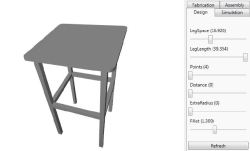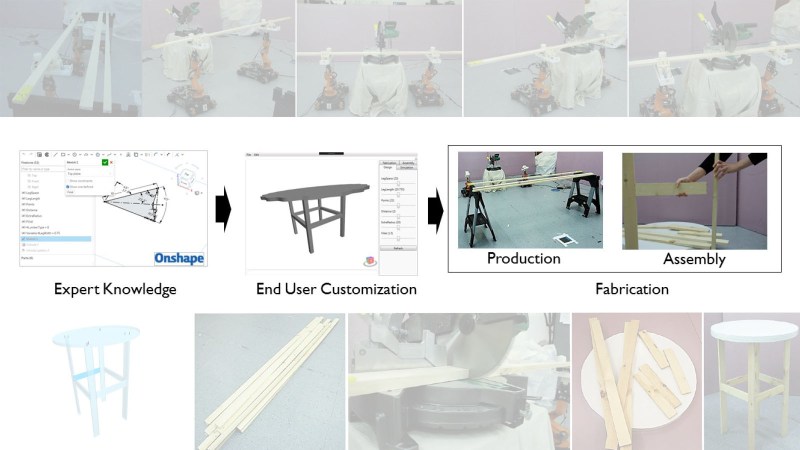Many people got their start with 3D printing by downloading designs from Thingiverse, and some of these designs could be modified in the browser using the Thingiverse Customizer. The mechanism behind this powerful feature is OpenSCAD’s parametric design capability, which offers great flexibility but is still limited by 3D printer size. In the interest of going bigger, a team at MIT built a system to adopt parametric design idea to woodworking.
 The “AutoSaw” has software and hardware components. The software side is built on web-based CAD software Onshape. First the expert user builds a flexible design with parameters that could be customized, followed by one or more end users who specify their own custom configuration.
The “AutoSaw” has software and hardware components. The software side is built on web-based CAD software Onshape. First the expert user builds a flexible design with parameters that could be customized, followed by one or more end users who specify their own custom configuration.
Once the configuration is approved, the robots go to work. AutoSaw has two robotic woodworking systems: The simpler one is a Roomba mounted jigsaw to cut patterns out of flat sheets. The more complex system involves two robot arms on wheels (Kuka youBot) working with a chop saw to cut wood beams to length. These wood pieces are then assembled by the end-user using dowel pegs.
AutoSaw is a fun proof of concept and a glimpse at a potential future: One where a robotic wood shop is part of your local home improvement store’s lumber department. Ready to cut/drill/route pieces for you to take home and assemble.
For now, IKEA hacking is still the best option for people who want human-scale structures but lack access to the necessary equipment to fabricate from scratch. Some past IKEA-related projects include motorized desk, building a robot arm out of a lamp, and naturally a 3D printer.
Thanks [Qes] for the tip















investor bait…. furniture makers are already heavily automated and have the economy of scale on their side. this will be a niche product at best; marketed to people with more money than common sense.
They are very automated, but maybe not set up to make things at custom sizes. They need to adapt there machinery and software to make that possible, but this can all be done with already existing technology and equipment that is readily available from several suppliers. IKEA video: https://youtu.be/Du2jj4BHJg4?t=14m55s
Somehow I’m reminded of a toy I had as a child.
https://img1.etsystatic.com/004/0/5836635/il_fullxfull.363207479_r3d2.jpg
I find most Ikea furniture to be wretchedly flimsy and cheap, so it seems pointless to challenge that. On the other hand, their selection of kitchen supplies, rugs, curtains, etc. is top notch. Without a doubt my favorite Ikea product is the lingonberry soda. http://www.ikea.com/us/en/catalog/products/20226767/
Note that we didn’t see the Roomba-saw falling onto the concrete after successfully cutting itself into a hole. :-)
another gimmick from MIT
What a load of bs. All of that already exists in much better executed ways. Why on earth would you need something like that puny little robot if you got CNC machines and its not like automatically cutting wood strips to length hasn’t been solved decades ago. If it were to cut cost then it also misses the point, for something like this machine cost really isn’t the issue, its a software and logistic problem.
As it has been said before, this nothing but investor bait…
The software side being built on web-based CAD software Onshape is the first problem with this project.
WE DO NOT WANT CLOUD BASED SOFTWARE THAT STOPS WORKING IF THE INTERNET GOES DOWN OR THEY GO OUT OF BUSINESS OR DECIDE THEY WANT TO CHARGE MORE OR THEY BREAK THINGS OR STOP SUPPORTING YOUR DESIGN VERSION!
In the future you will never own. You will only rent.
Rent a Family.
In the future you will never write. You will only vent.
If you are shouting, at least be correct.
There is nothing wrong with web-based software (and file storage/share solutions) as long as you can copy and modify the source code and at least have the option to run it on your own server.
A lot of desktop-based software needs a permanent or at least regular internet connection to stay activated, and there are plenty of problems with getting older versions or discontinued products that you bough (not rented!) activated. (try getting Autocad 2004 re-activated legally, to use some 32-bit win-XP-only Autocad plugins).
Web based software with open source options or the ability to run and deploy your own implementation is not inherently bad or undesirable.
However, Onshape is exclusively a Software as a Service model. There is no code you can download. It is not open source. You cannot run your own code. It has to be run as a thin client and you are effectively letting them hold your entire CAD workflow hostage.
If you activated Autocad 2004 previously, you can just open it up and run it. It still works and still opens the files you created and newer versions most likely will continue to open the file but if it does not do so, at least you can open 2004 and still work with the file, as opposed to the software randomly deeming that project “unsupported” one day or even worse, opening it up but silently changing things due to some random dimensional bug rounding fix.
If you are making a point, at least be correct. People don’t “bough” software.
While it’s true you will have a hard time *legally* activating it, it’s still possible to do. Virtualization will take care of most of the OS compatibility issues.
With closed source web based software, you are completely at their mercy.
This is important when you have old design files from decades ago that you need to work with.
Well fortunately CAD as a category is well stocked. I’m sure someone, in between typing in all caps, can move their work to other platforms.
I dont agree, there is no standardized file format that allows you to move information from one program to another while maintaining the history of the design itself. Sure you can move stl files between the different programs but the entire CAD industry is based off of vendor lock-in.
That doesn’t change my argument that their work can be moved to another CAD platform.
“AutoSaw draws on expert knowledge for designing, and robotics for the more risky cutting tasks. Using the existing CAD system OnShape with an interface of design templates, users can customize their furniture for things like size, sturdiness, and aesthetics. Once the design is finalized, it’s sent to the robots to assist in the cutting process using the jigsaw and chop-saw.”
No “history retention” needed. Not that an RCS can’t handle that aspect.
Sometimes, many things *can* be moved over. Well, mostly moved over, with exceptions. But doing so is basically equivalent right now to something more akin to rendering an entire 4K resolution animation and then saving it as a VHS format (maybe DVD if it is simple) and then trying to recreate it as a fully rendered 4K form again without access to anything except the VHS format. Sure, you *can* do so but it is entirely not automated and you will invariably lose things along the way, plus the new software package probably doesn’t support the same things plus it is, well, new software as well so it might implement things differently or not at all or simply do so differently.
Not everybody will need history retention but that’s far from the only issue at play here. Every single major CAD package basically amounts to a series of islands that are better now about letting you sometimes import some limited things but do not play nicely with each other in terms of full feature support. Many lack backwards compatibility if you so much as save a file as the latest format, even if the model does not use a single new feature.
If Onshape went out of business or stopped offering product updates, any company that was using them would basically be unable to even use their CAD package and every single CAD file they had at all. Somebody might try to put together a workaround or provide some kind of limited crossover tool but why even do that to begin with?
something like thingiverse but for woodworking would be much better. This just does not have what anyone wants. items just are not cut in wood shops just like machine shops they nest and get the most of the material they have at hand. kinda interesting but more whatever IMHO. also dude CAPS your doing it wrong
This just does not have what anyone wants.
It helps a professor get a few more papers published. That’s all that mattered.
more papers = more funding = higher salary
Just using the CAD templates to generate a cut list for the manual woodworker would be a big help
A Roomba equipped with a saw? CNC routers don’t exist anymore? What happened?
Looks like a rigged demo. For example, it’s highly unlikely that the Roomba can execute the cut shown with any sort of repeatability, even if there is closed loop control of positioning. They are bad enough at repeating motions when there is no load, so when driving a tool, even through foam, they are apt to be useless.
I am betting that part of the demo involved several takes to get one that looked good enough to.use.
You did notice the Roomba was cutting polystyrene foam…?
And I think that makes this worse instead of better :-(
What I don’t get is why there is no standard open-source CAM format. For 3D printing, we have STL which is a reasonable way of representing a part as a bounding surface and seems pretty universally accepted.
What about for everyone that has a CNC router or plasma cutter instead of a 3D printer? Where arbitrary surface profiling (e.g. decorative bas-relief) is called for then STL is a reasonable start, but most furniture and/or functional designs are expressed as machine-ops (pocket, outline, drill, engrave, etc) attached to usually-2D geometry, which is then cut from sheets of flat material.
I think it would be useful for there to be a simple human+machine-readable, e.g. XML, format for exchanging CAM designs. Not toolpaths, just geometry+operations; the recipient of the file can generate toolpaths in the same way that if you want to print an STL, you need to slice it to get G-code.
Please tell me I’d be reinventing the wheel if I created such a format?
Not that it’s a great option, but I’ve increasingly been seeing SVG used for 2d drawings. The kickstarter sweetheart Glowforge (another example of lock-in through SaaS) uses it as its primary format. It’s well supported by most of the usual tools for vector art, but Inkscape shines here. EPS is another 2d drawing format which is equally unsuitable for CAD, but I’ve seen it used in that arena since the MS-DOS days. Speaking of Inkscape, CAD, and the MS-DOS era, Inkscape also supports the venerable Autodesk-designed DXF format, which has been broadly supported by open and closed source software since the 1980s.
I’ve even seen a CAD program which supported a turtle graphics format. Then there are the dozens of formats related to GIS, many of which are also somewhat suitable for CAD. Open 2d vector formats have an embarrassment of choices, which is the reason there isn’t any one standard one, just a lot of compatible formats that almost everybody supports. Sadly it’s been this way since the 80s. I remember buying time in high school on Compuserv to download a file which took files from DXF to the fancy new open source raytracer POVRay format.
I’m was surprised that SVG isn’t used for gcode to describe each layer, but then I realized that stl’s don’t have any curves, so there is no point in the added complexity.